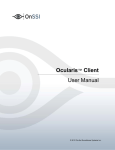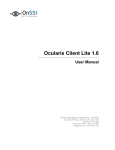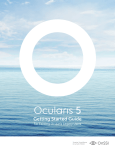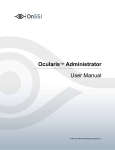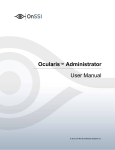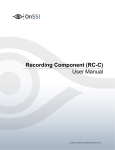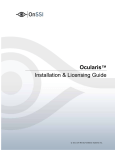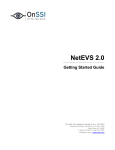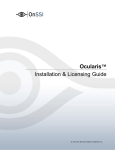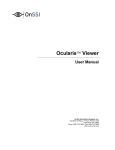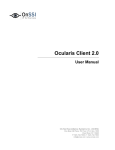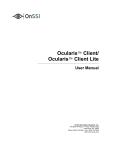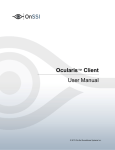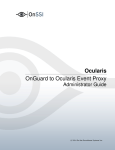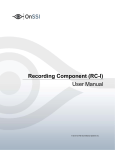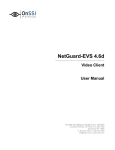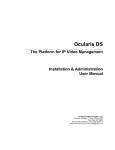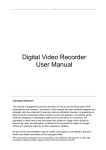Download Ocularis Client Lite Manual
Transcript
Ocularis Client Lite User Manual On-Net Surveillance Systems Inc. (OnSSI) One Blue Hill Plaza, 7th Floor | P.O. Box 1555 Pearl River NY 10965 P: 845-732-7900 | T: 845-732-7900 [email protected] | www.onssi.com This page intentionally left blank. On-Net Surveillance Systems, Inc. Ocularis Client Lite Table of Contents Table of Contents INTRODUCTION..............................................................................................................................1 1. INSTALLATION AND LOGIN ................................................................................................2 MINIMUM SYSTEM REQUIREMENTS ....................................................................................................2 Installation from CD ...................................................................................................................2 Installation from the OnSSI website ..........................................................................................2 LOGGING IN TO THE NVR SERVER....................................................................................................3 2. VIEWS ....................................................................................................................................4 VIEWS AND VIEW GROUPS ...............................................................................................................4 View Elements ...........................................................................................................................5 CREATING VIEWS AND VIEW GROUPS ...............................................................................................6 POPULATING VIEW PANES ...............................................................................................................8 Populating a view pane with a camera ......................................................................................9 Populating a view pane with a Hotspot......................................................................................9 Populating a view pane with a Carousel..................................................................................10 Populating a view pane with a web page or image .................................................................11 Populating a view pane with Push Video.................................................................................12 Saving changes and testing the view ......................................................................................12 3. LIVE MONITORING WITH INSTANT INVESTIGATION .....................................................13 DISPLAYING VIEWS ........................................................................................................................13 INSTANT INVESTIGATION AND CAMERA CONTROL DURING LIVE MONITORING ....................................14 View Pane Controls .................................................................................................................14 Instant investigation tools ........................................................................................................17 4. BROWSING (INVESTIGATION MODE) ..............................................................................20 SHIFTING BETWEEN LIVE AND BROWSE MODES ...............................................................................20 THE BROWSE (INVESTIGATION) WINDOW ........................................................................................20 The Scalable Kinetic Timeline .................................................................................................21 Browse Mode Controls ............................................................................................................22 MOTION DETECTION ......................................................................................................................23 i On-Net Surveillance Systems, Inc. Ocularis Client Lite Table of Contents Applying motion detection to recorded video...........................................................................23 THE TIME SLICER ..........................................................................................................................25 Accessing video of an incident using the Time Slicer..............................................................26 THE MOTION SLICER .....................................................................................................................28 Accessing video of an incident using the Motion Slicer...........................................................28 ALERTS.........................................................................................................................................29 Accessing video of an incident using Alerts ............................................................................29 SEQUENCES ..................................................................................................................................31 Accessing video of an incident using Sequences....................................................................31 5. EXPORTING EVIDENCE (VIDEO AND STILL IMAGES) ...................................................33 EXPORTING VIDEO EVIDENCE ........................................................................................................33 Designating a range for exporting video..................................................................................33 Exporting an AVI video clip......................................................................................................34 Exporting a Video Database ....................................................................................................37 Exporting Still Images (individual frames) ...............................................................................39 Printing a Still-Image Report....................................................................................................41 ii On-Net Surveillance Systems, Inc. Ocularis Client Lite Introduction Introduction Ocularis Client Lite is a feature-rich IP video client/controller that allows users to: Monitor live video from an unlimited number of cameras at multiple sites, with instant-investigation capabilities. Easily access and investigate alerts, generated by both motion detection and external systems. Send and receive automated push-live-video of alerts. Export video clips and still images for further event handling or as court evidence. Legal Notice This product manual is intended for general information purposes only, and due care has been taken in its preparation. Any risk arising from the use of this information rests with the recipient, and nothing herein should be construed as constituting any kind of warranty. OnSSI reserves the right to make adjustments without prior notification. (C) 2008 On-Net Surveillance Systems, Inc. OnSSI, the ’Eye’ logo, Ocularis, NetDVMS, NetEVS, NetDVR, ProSight, NetGuard, NetGuard-EVS, NetSwitcher, NetMatrix, NetTransact, NetCentral, NetPDA and NetCell are registered trademarks of OnSSI. Other names are the property of their respective owners. 1 On-Net Surveillance Systems, Inc. Ocularis Client Lite Installation and Login 1. Installation and Login Minimum system requirements Operating System: Microsoft® Windows® XP Professional CPU: Intel® Pentium® 4, 2.4 GHz or Higher (Core 2™ recommended) RAM: 1 GB Network: Ethernet (100 Mbit or higher recommended) Graphics Adapter: PCI-Express, 128 MB RAM, Direct 3D supported Installation Installation from CD 1. Insert the software installation CD. The CD’s main menu will auto-play. 2. Click on ‘Software Installation’ to initiate the installation. Click ‘Accept’ if a security warning appears 3. Follow all installation instructions. Installation from the OnSSI website 1. Download the Ocularis Client Lite installer from the OnSSI website. 2. Click on ‘Software Installation’ to initiate the installation. Click ‘Accept’ if a security warning appears 3. Follow all installation instructions. Note: In some cases you may be prompted to download and install one or more auxiliary software applications (typically .NET and DirectX). The installation wizard will guide you through the installation of these applications. 2 On-Net Surveillance Systems, Inc. Ocularis Client Lite Installation and Login Logging on to Ocularis Client Lite 1. Launch Ocularis Client Lite. The login window will appear. 2. Enter your login information, as follows: The Login Dialog User Name and Password : The user name and password for logging in to the NVR server depends on the type of Authentication used. For Basic authentication, enter the user name and password that were set up in the NVR Image Server; for Windows authentication, enter your Windows user name. Server address: Type the host name or IP address of the NVR Server, including port number, as specified by your system administrator (e.g. 192.168.10.123:81). Previously entered IP addresses can be selected from the drop-down list. Authentication: Choose Basic or Windows, as instructed by your system administrator. Store Last Login: Both User Name and Password will be automatically entered upon login. Auto-Login: Automatically launches Ocularis Client Lite and logs in to the NVR server, upon logging in to Windows; requires checking the ‘Store Last Login’ check box. 3 On-Net Surveillance Systems, Inc. Ocularis Client Lite Views 2. Views Views and View Groups In Ocularis Client Lite, cameras are displayed within Views. A view can contain up to 64 cameras. Multiple views can be configured, and displayed simultaneously across multiple monitors. To easily access specific views, and to allow users to personalize their monitoring preferences, Ocularis Client Lite operators can access both Shared Views and Private Views, stored in groups and subgroups: Shared Views, usually created by the surveillance system administrator and stored on the NVR the user is logged in to, can be accessed by all users or by a group of users based on authorization. Private Views can be accessed only by the user that created them. Note: Views created in OnSSI NetGuard-EVS can be accessed and edited in Ocularis Client Lite. 4 On-Net Surveillance Systems, Inc. Ocularis Client Lite Views View Elements Different panes within a view can be set to display video in one of the following modes: Camera panes: Any camera from a connected NVR server can be displayed within a camera pane. Upon interaction, instant investigation controls will appear, including controls for playback and optical and digital PTZ. Carousel panes: Cameras can be displayed in sequence, configured by order and dwell time. Carousel views also display all playback and PTZ controls, as well as controls for previous/next camera and pause/resume carousel. Web pages and images: Web pages and images can be included in views as auxiliary resources. Alert panes: One or more alert panes can be configured to be populated with on-event (automated) or peer-topeer NetMatrix push-video. Hotspot pane (not shown): Usually configured in a large pane, the hotspot will display cameras by clicking on a camera, alert or carousel pane. Once sent to the hotspot, the original and the hotspot displays can be controlled independently. Additional Options Carousel with instant investigation, optical and digital PTZ, and carousel controls Camera Panes with instant investigation as well as optical and digital PTZ Live web page Push Monitor Static Image 5 Alert Pane, for receiving automatic or manual (peer-topeer) push-live-video On-Net Surveillance Systems, Inc. Ocularis Client Lite Views Creating Views and View Groups 1. Click on the Setup Utility icon, located on the right-hand side of the menu bar. The icon will appear when hovering over it. The Setup icon Note: Access to the Setup utility can be limited to authorized users by changing their privileges in the NVR’s Image Server Administrator utility. 2. The View Setup/Editing utility will be displayed: Shared and private Views General View controls View Panes Cameras and inputs Properties for each type of input/element The Ocularis Client Lite Setup Utility (1+5 view) 6 On-Net Surveillance Systems, Inc. 3. Ocularis Client Lite Views Views are organized within folders. The top tier folders are ‘Shared’ – views that can be accessed by all users, and ‘Private’ – views that are accessible only by the user who created them. The View Tree structure Note: The ability to edit either shared or private views can be limited based on the user’s privileges on the NVR server. 4. To create subfolders, highlight a folder, and click the New Folder icon [ ], located on the bottom left of the Folders/Views pane. 5. To create a view within a folder, click on the Create View icon [ ]. This will open a submenu of view layout templates, for both regular (3:4) and widescreen display aspect ratios. 6. At any point during the View creation process, you can: Rename [ ], and Delete [ ] Views Save changes, without closing the editor; [ 7 ] On-Net Surveillance Systems, Inc. Ocularis Client Lite Views Populating View Panes View panes are populated with cameras, hotspots, carousels, web-pages, images and push video elements. To populate a pane, simply drag the desired element into the pane. If the pane is already populated, the dragged view element will replace the previous element. The Cameras panel in the Setup utility 8 On-Net Surveillance Systems, Inc. Ocularis Client Lite Views Populating a view pane with a camera In the Cameras panel in the setup utility, click on the [+] sign beside ‘Server’ to expand the list of cameras available through the NVR server. List of cameras connected to an individual NVR server 1. Drag the desired camera into one of the view panes. The camera view, as well as the camera name, will appear in the pane. 2. To display a different camera or view element, simply drag another camera or view element into the pane. Populating a view pane with a Hotspot Hotspots are usually used in a layout made of one or more large view panes surrounded by smaller panes. In a view containing hotspots, selecting a hotspot and clicking on any other pane will send the camera displayed in the pane to the hotspot. This applies only to camera, push-video and carousel panes. 1. In the Cameras panel, click and drag the ‘Hotspot’ icon into the desired View pane. 2. Set the hotspot display parameters for the quality and framerate of the video displayed in the hotspot in the Properties panel. Adjust these properties based on the type of camera, amount of bandwidth consumed by the camera and type of movement displayed. Properties setup for Hotspot pane 9 On-Net Surveillance Systems, Inc. Ocularis Client Lite Views Populating a view pane with a Carousel The Carousel mode of viewing enables sequential monitoring of multiple cameras. In Ocularis Client Lite, with full interaction with the image displayed including playback, PTZ and carousel sequence controls. 1. In the Cameras panel, click and drag the ‘Carousel’ icon into the desired View pane. This will automatically change the contents of the Properties panel. Global properties setup for Carousel panes 2. Set the Carousel display properties for quality and framerate. Adjust these properties based on the type of camera, amount of bandwidth consumed by the camera and type of movement displayed. 3. Set the Default Dwell Time (in seconds) for the carousel. The dwell time can also be set for individual cameras, as described later. 4. Click on the ‘Edit List’ button to add cameras to the carousel. 5. Expand the cameras list, and drag the desired cameras into the carousel list. The Carousel Cameras list 6. Each camera in the carousel can be configured for placement in the carousel sequence (using the up and down buttons). To remove a camera from the carousel, click the delete [ 10 ] icon. On-Net Surveillance Systems, Inc. 7. Ocularis Client Lite Views Click on the ‘Save’ button in the ‘Properties’ panel to save the carousel contents and display parameters. This will display the View with the carousel cameras stacked one above the other. You can browse through the carousel cameras by clicking on a camera in the stack. Populating a view pane with a web page or image Any view pane can display a web page or a static bitmap image (JPEG, BMP, PNG or GIF). 1. In the Cameras panel, click on the ‘Web Page’ icon and drag it into the desired View pane. This will automatically change the contents of the Properties panel. 2. In the ‘Web URL’ text box, enter the local or remote address of the web page or the image to be displayed, e.g. ‘http://www.onssi.com’ or ‘D:\building_14_floor_plan.png’. Properties setup for browser or static image panes 3. Click on ‘Set’ to display the web page or image. Note: Ocularis Client Lite’s web page utility may not support all navigation and display capabilities of fullfledged web browsers, and thus should not be used as a replacement for a web browser for missioncritical tasks. 11 On-Net Surveillance Systems, Inc. Ocularis Client Lite Views Populating a view pane with Push Video Push Video panes are configured to display on-event live video stream alerts, as configured in the NetMatrix push-video utility. Ocularis Client Lite can accommodate multiple Push Video panes. In such a case, events will be displayed in first-in-first-out order, rotating between the different Push Video panes. 1. In the Cameras panel, click the ‘Push Video’ icon and drag it into the desired View pane. This will automatically change the contents of the Properties panel. Properties setup for Push Video panes 2. Set the display properties for quality and framerate. Adjust these properties based on the type of cameras in the system, available bandwidth and type of movement to be displayed. 3. Enter the TCP/IP port and password as defined in NetMatrix (for more information, please refer to the NetMatrix user manual.) All Push Video panes share the same NetMatrix TCP/IP port number. 4. Click on a different video pane to complete the push video setup. Saving changes and testing the view 1. Once you’ve completed populating all of the view panes, it is important to save the changes made, by clicking on the ‘Save’ [ 2. ] button. To test the view, exit (close) the View Setup utility. The newly-created view will be displayed on the main Ocularis Client Lite panel. The method of launching views and interacting with video is described in the following sections. 12 On-Net Surveillance Systems, Inc. Ocularis Client Lite Live Monitoring with Instant Investigation 3. Live Monitoring with Instant Investigation Displaying Views Once views were created in the system, either in Ocularis Client Lite or in NetGuard-EVS, they can be displayed and operated. To display a view: 1. Click on the ‘Views’ menu bar item. 2. Click on ‘View Layouts’ to expand the list of views; continue to expand folders and subfolders until you reach the desired view. 3. Click on the desired view. Depending on your system’s settings, it may take a few seconds until all panes are populated. A blinking green indicator will indicate a live video stream from the camera. The Live Monitoring window 13 On-Net Surveillance Systems, Inc. Ocularis Client Lite Live Monitoring with Instant Investigation Instant Investigation and Camera Control during Live Monitoring Ocularis Client Lite provides multiple tools for adjusting the contents of view panes, sending video alerts, and on-the-fly investigation of the video displayed. View Pane Controls Toggle between pane and full-screen display modes Click on the camera pane top bar (which displays the camera name) to toggle between multiple camera view and full screen display modes. Change cameras on-the-fly Right-click on a camera view, or left-click or touch and hold for one second, to display the circular pane controls menu. Note that on-the-fly changes are only temporary, and will not affect the saved view. The circular pane controls menu Note: Optical PTZ cameras employ a virtual joystick control that will appear in the middle of the pane upon mouse-over or clicking. To display the circular pane controls menu using left-click or touch, click or touch the screen off-center within the camera pane. Click on the camera icon [ ] at the top-right quadrant of the circular menu to display the camera list. Click on a camera to display it in the desired pane. Click-drag to scroll up and down the list. The Select Camera list; click on a camera to display it in the view pane 14 On-Net Surveillance Systems, Inc. Ocularis Client Lite Live Monitoring with Instant Investigation Copy a still camera image to the clipboard Right-click on a camera view, or left-click or touch and hold for one second, to display the circular pane controls menu. Click on the clipboard icon [ ] in the bottom-right quadrant of the circular menu. This will save a still camera image to the clipboard which can be pasted into different applications. Push a live camera stream to another user Live video alerts can be pushed automatically (via OnSSI NetMatrix) or manually, as described herein, to other users’ designated alert panes (see ‘Populating a View Pane with Push Video’ in the ‘Configuring Views’ section.) Right-click on a camera view, or left-click or touch and hold for one second, to display the circular pane controls menu. Click on the push video icon [ ] in the top-left quadrant of the circular menu. This will display the recipients list. Click on a recipient to send live video; click-drag to scroll up and down the list. The Push Live Video recipients list Note: Please refer to the NVR user manual for NetMatrix Push Video Configuration. 15 On-Net Surveillance Systems, Inc. Ocularis Client Lite Live Monitoring with Instant Investigation Remove a camera from camera pane Right-click on a camera view, or left-click or touch and hold for one second, to display the circular pane controls menu. Click on the Remove Camera icon [ ] in the bottom-left quadrant of the circular menu to remove the camera from the pane. Note: Removing as camera from a view pane as described above will only delete it temporarily; permanent removal of a camera from a view can only be done through the View Setup Utility. 16 On-Net Surveillance Systems, Inc. Ocularis Client Lite Live Monitoring with Instant Investigation Instant investigation tools Playing back video Upon mouse-over, clicking or touching any camera view, whether in full-screen or pane mode, playback controls will pop up. Click continuously on the ‘Forward’ (right arrow) or ‘Rewind’ (left arrow) buttons to review video. Releasing the buttons will pause the video stream. Note that clicking on the ‘Forward’ button while viewing live video will pause the video stream. Pause a live video stream by using the ‘Pause’ button, and resume live video by clicking the heartshaped ‘Live’ [ ] button. Applying Digital PTZ Digital PTZ can be applied to video in any mode or pane, live or recorded. To apply digital PTZ, click-drag or touch-drag a rectangular region within the camera view. The selected region will expand to the entire size of the camera display. Note that the default for optical PTZ cameras is optical zoom, therefore the ‘Digital PTZ’ option must be selected prior to drawing a Digital PTZ region. Digital PTZ in live monitoring mode. Note PIP window (right) A PIP (picture-in-picture) of the entire camera view, indicating the selected digital PTZ area, will appear in the top right corner of the camera view, for orientation and navigation. The selected area can be dragged within the PIP, maintaining the same magnification level. Click or touch the camera view (outside of the PIP window) to remove the digital PTZ and return to normal camera view,. 17 On-Net Surveillance Systems, Inc. Ocularis Client Lite Live Monitoring with Instant Investigation Optical PTZ Ocularis Client Lite offers a number of methods for controlling PTZ-enabled cameras. Note: Not all controls are available in conjunction with every PTZ camera model. 1. Click to Center: click on any point within the camera view to center the camera on it. 2. Virtual Joystick: hover over or touch the center of the camera view to display the virtual PTZ handle, and drag it in any direction for continuous panning and tilting. The Virtual PTZ Joystick 3. Physical joystick: standard USB joysticks can be used to pan, tilt and zoom the camera view. This may require configuring the joystick buttons. 4. Click-drag/touch-drag region: draw a region within the camera view to center the camera and set the zoom level. 5. Mouse Scroll Wheel: optical zoom in/out can be applied in any mode (including digitally-zoomed camera views) using a scroll-wheel mouse. 6. Zoom control ribbon: click on any point on the zoom ribbon, or use the [+] and [-] buttons, to set the zoom level. The Zoom Control Ribbon 18 On-Net Surveillance Systems, Inc. 7. Ocularis Client Lite Live Monitoring with Instant Investigation Optical PTZ presets: Click on the ‘Presets’ button alongside the playback controls to display the PTZ presets as configured in the NVR (see the NVR user manual for more information.) This will display the presets list. Click on an item on the list to display the PTZ preset, or click-drag up and down to scroll the available presets. The Optical PTZ Presets list 8. Toggle between optical and digital PTZ: Click the ‘Optical PTZ’ button to toggle between digital and optical PTZ. Carousel sequence control Carousel panes can be controlled just like any other camera pane, for playback, digital PTZ and optical PTZ. In addition, Ocularis Client Lite enables skipping to the next and previous camera in the carousel sequence, as well as pausing the sequence. Once paused, the carousel will show the last camera indefinitely. To resume the carousel view, click on the previous or next camera buttons. The Carousel Sequence controls; left to right: previous camera, pause/resume sequence, next camera 19 On-Net Surveillance Systems, Inc. Ocularis Client Lite Browsing (Investigation Mode) 4. Browsing (Investigation Mode) Ocularis Client Lite’s Browsing mode includes a variety of tools for quick, easy access to video of incidents, reviewing the events before, during and after the incident, and for exporting segments of video for evidence. Shifting between Live and Browse modes In the top menu bar, click Browse to shift to Browse mode. Once in Browse mode, the menu item will change to Live for returning to Live monitoring. Upon switching between live and browsing, the currently displayed camera view will carry between the modes. This includes current cameras displayed in full screen, carousel panes, hotspots push-video panes. As opposed to the Live Monitoring view, which displays multiple cameras a-synchronously (i.e. different panes can show playback, paused and/or live cameras simultaneously), the Browse mode displays all cameras synchronously. This provides insight as to the events taking place at different locations at the time an incident occurred, and allows easily tracking an incident as it moves from camera to camera. The Browse (Investigation) Window Current time (may differ from displayed video time) Camera name and time/date of video displayed Kinetic Motion Timeline, with video time stamp and timeline scale Browse Mode controls The Browse Window Ocularis Client Lite’s Browse window offers a number of tools and methods for accessing and enhancing video of incidents: 20 On-Net Surveillance Systems, Inc. Ocularis Client Lite Browsing (Investigation Mode) The Scalable Kinetic Timeline The Kinetic Timeline provides a clear overview of recorded motion events over extended periods of time. It can be used for reviewing video from multiple cameras simultaneously at variable speeds, for quick access to video of incidents. Browse Mode controls Color-coded zones of recording and detected motion Timestamp of video displayed 10-minute interval markers Timeline Scaling controls The Kinetic Timeline Timeline Color-Coding Color-coded segments in the timeline are used to indicate whether video has been recorded at a certain time, and whether motion was detected during those periods: o Black: no video was recorded o Green: video was recorded, but no motion has been detected o Red: video was recorded, containing motion events o Blue: indicates the future, starting from the current time. Scaling the timeline Use the [+] and [-] buttons to scale the timeline, thus extending or contracting the time period displayed. As the Timeline is scaled, marker lines spaced at 10-minute increments will contract or expand. Playing video using the timeline The Kinetic timeline allows for quickly scanning extended portions of recorded video from one or multiple cameras. ‘Swiping’ the timeline (rapidly dragging and releasing while still in motion) in either direction will play the video at a speed proportional to the speed of the swiping motion. The Timeline can also be used for ‘shuttle’-style playback by click-dragging the timeline in a slow, controlled manner. Using the timeline in multiple-camera views In multiple-camera views, the Timeline at the bottom of the Browse window refers to the selected camera (indicated by a blue frame around the camera pane), while all other cameras maintain an individual timeline at the bottom of each camera pane . Click on another camera pane to select it; this will automatically associate the main Timeline with the newly-selected camera. 21 On-Net Surveillance Systems, Inc. Ocularis Client Lite Browsing (Investigation Mode) Browse Mode Controls Ocularis Client Lite’s Browse Mode Controls allow for precise playback control and access to events by motion sequence, frame-by-frame playback, normal-speed playback and time/date. This group of controls also provides access to the motion detection toolbar, and is used to initiate video exporting. Apply video motion detection Frame-byframe forward/ rewind Skip to next/previous sequence Go to start/end of database The Browse Mode Toolbox Normal speed play/reverse play Set start/end of segment for video export Go to time/date Apply Video Motion Detection Transition to Motion Detection mode (described in the next section.) Frame-by-frame forward/rewind Review video frame-by-frame in both directions. Next/previous motion sequence Motion sequences display the actual starting point of detected motion occurrences. Go to start/end of database Access directly the beginning of the video database and the current time. Normal speed playback Review recorded video at normal speed, both forward and backward. Click on the timeline to pause. Set start/end of bookmark Graphically set the start and end points of video segments, towards exporting video as evidence (described in the ‘Video Export’ chapter.) Go to Time/Date Access video from a specific time and date; scroll up and down the time unit rollers to set the exact time and date. The time/date utility 22 On-Net Surveillance Systems, Inc. Ocularis Client Lite Browsing (Investigation Mode) Motion Detection Motion detection enables expediting the event detection process, by eliminating the need to manually review volumes of video data. Motion can be detected within a defined zone, and the detection process can be configured to the exact parameters of the targeted behavior or movement. Applying motion detection to recorded video 1. Click on the Motion Detection button [ ] in the Browse Mode toolbox. This will replace the Browse Mode controls with the Motion Detection Controls. Return to Browse Window Skip to next/previous motion event Set percentage of changed pixels Set time interval for detection Set detection sensitivity Go to start/end of database Go to time/date The Motion Detection toolbox 2. Draw a rectangular region in the camera pane. A motion level gauge will appear on the bottom of the region. 3. Set the motion detection parameters, to match the nature of the targeted movement: • Time Interval (sampling rate) Set this parameter based on the duration of the motion event. Set a high sampling rate (e.g., frame-by-frame) for vehicles on a roadway, as they may enter and exit the detection region within a fraction of a second. On the other hand, large values should be set for slow moving persons or objects. Available values are frame-by-frame (FBF), 1, 5, 10 and 30 seconds. 23 On-Net Surveillance Systems, Inc. Ocularis Client Lite Browsing (Investigation Mode) • Percentage of changed pixels Set this parameter based on the size or area of the movement, relative to the detection region. For example, set a high value or detecting a vehicle entering a detection region the size of a single parking space; this will prevent false detections of persons walking in the parking lot. Values range from 1% to 99%. • Sensitivity This parameter defines the amount for pixel color and brightness change. Set this parameter according to the amount of ‘noise’ caused by ambient lighting, shadows, reflections from windows, etc. For example, reduce the detection sensitivity for detecting maritime movement in waterways, prevent false detection caused by waves. 4. Set the start time for motion detection. Use the ‘Go To Time/Date’ utility, skip to the beginning or end of the recorded video database, or drag the timeline to the desired time and date. 5. Click the ‘Skip to Next/Previous Motion Event’ to begin searching, going either back or ahead in time. 6. Adjust the time interval, pixel change and detection sensitivity parameters if too many or too few motion events are detected. 7. Click ‘Return to Browse Mode’ to return to the primary Browse Mode view. 24 On-Net Surveillance Systems, Inc. Ocularis Client Lite Browsing (Investigation Mode) The Time Slicer Ocularis Client Lite’s Time Slicer functionality enables users to easily and quickly access video of an incident by auto-generating equal-interval thumbnails of a specific camera view. Once the incident is evident in one of the thumbnails, the user can create sets of thumbnails of increasingly smaller time intervals, towards accessing the exact moment the incident began or ended. Time Slicer Current View pane Timeslice thumbnails Mode Selector Timeslice direction (back/forward in time); pause slicing Time Slicing Interval Kinetic Motion Timeline, with video time stamp and timeline scale Interchangeable Motion Detection/ Playback Controls The Time Slicer 25 On-Net Surveillance Systems, Inc. Ocularis Client Lite Browsing (Investigation Mode) Accessing video of an incident using the Time Slicer 1. In Browse Mode, click on the Timeslice menu item. 2. The Time Slicer will generate thumbnails of the currently selected camera view, spaced 10 minutes apart, starting from the currently displayed time-stamp and back in time. The Timeslice Current View pane displays the camera view at the current time stamp (indicated on the Kinetic Timeline.) 3. For convenient detection limited to a certain part of the camera view, you may apply digital zoom by drawing a rectangular region in the Timeslice Current View. This will change the zoom level in all Timeslice thumbnails. 4. Depending on the nature of the incident searched, you may adjust the initial time interval and the direction of detection (back or forward in time). Use a larger interval to detect significant or semi-permanent changes to the current camera view, that occurred days before or after the current time stamp (e.g. set the interval to One Day to detect damage to a building that occurred within the past week.) Use a smaller interval to detect short-term, transient incidents that occurred within hours or minutes of the current time-stamp (e.g. use the default 10-minute interval, or even a 1-minute interval to detect a car that had parked within half an hour of the currently displayed video.) 5. ], depending on the desired direction of Click on the Search Back/Forward buttons [ detection, to generate the next set of thumbnails, starting at the time-stamp of the bottom-right thumbnail. 6. Once a change has been detected between two consecutive thumbnails, indicating that the incident has occurred in the time between the two frames, click on the first of the two (if searching back in time; click in the second frame if searching forward in time). The selected thumbnail will populate the Timeslice Current View pane, and the Timeline will move to the selected thumbnail’s time stamp. 7. Select a smaller interval and click the Search Back/Forward buttons to generate thumbnails of smaller intervals, and repeat the process until the exact start or end time of the incident is accessed. 8. At this point, you can: Apply motion detection to the Timeslice Current View pane: motion detection can be applied to the Timeslice Current View pane in the same manner as any Browse Mode pane. See ‘Motion Detection’ (page 23) for more information. 26 On-Net Surveillance Systems, Inc. Ocularis Client Lite Browsing (Investigation Mode) Review the selected camera or the entire camera view at the time of the detected event: click on the camera’s title bar to expand it to full-view, or click ‘Overview’ in the main title menu to resume multi-camera browsing. Export video and/or still images for evidence: see ‘Exporting Evidence’, page 33. Note: If no video is recorded at a Timeslice point, the Time Slicer will search for and display the next frame of recorded video (both back and forward in time.) Time Slicing will resume from that point on at the set interval. 27 On-Net Surveillance Systems, Inc. Ocularis Client Lite Browsing (Investigation Mode) The Motion Slicer Similar to the Time Slicer, the Motion Slicer enables instant detection of motion events, adjusted for the duration of the event and level of motion. Accessing video of an incident using the Motion Slicer 1. Within the Time Slicer, click on ‘Motion’. 2. Set the Motion Slice detection parameters, based on the nature of the motion detected. The sampling frequency, denoted in intervals ranging from frame-by-frame to 1 minute, complies to the speed of the object or duration of the event. The percentage of change determines the minimal number of changed pixels (from within the digitally-zoomed image) for an event to be detected. Note: For more information about setting motion detection parameters, see ‘Motion Detection’, page 23. 3. Draw a Motion Detection zone using the motion detection tool [ 4. Click on the Back/Forward buttons [ ] in the Browse Mode toolbox. ], depending on the desired direction of detection, to generate thumbnails of detected motion events. At any point during the detection process you may click the pause button [ 5. ] to abort the operation. If needed, adjust the detection parameters and repeat the search. Unless a different thumbnail from the first is selected, or the timeline is moved, the search will resume from the same point. 6. Once the maximum number of twenty thumbnails per page is reached, the Motion Slice process will halt. To continue, click on either the Back or Forward buttons to resume detection. 7. Once the desired motion event is accessed, you can: Apply motion detection to the Motion Slice Current View pane: motion detection can be applied to the Motion Slice Current View pane in the same manner as any Browse Mode pane. See ‘Motion Detection’ (page 23) for more information. Review the selected camera or the entire camera view at the time of the detected event: click on the camera’s title bar to expand it to full-view, or click ‘Overview’ in the main title menu to resume multi-camera browsing. Export video and/or still images for evidence: see ‘Exporting Evidence’, page 33. 28 On-Net Surveillance Systems, Inc. Ocularis Client Lite Browsing (Investigation Mode) Alerts Alerts are messages generated by the NVR in response to motion detection instances or generic events received from external systems (e.g. access control, emergency phones, etc.) Multiple alerts and alert types can be associated with a single camera. Note: See the NVR’s user manual for more information about setting alerts. The Alerts List Accessing video of an incident using Alerts 1. Within the Time Slicer, click on ‘Alerts’ 2. Browse by Server, Camera and Alert and select the desired alert. 3. Starting at any point in the timeline, click on the Back/Forward buttons [ ], depending on the desired direction of viewing alerts. This will populate the screen with thumbnails of the camera at the time of each alert. At any point during the detection process you may click the pause button [ 4. ] to abort the operation. Hover over a thumbnail to enlarge it, or click to set the Timeline and the Currently Displayed Camera pane to the time stamp of the alert. 29 On-Net Surveillance Systems, Inc. 5. Ocularis Client Lite Browsing (Investigation Mode) Once the maximum number of twenty thumbnails per page is reached, the Alerts process will halt. To continue, click on either the Back or Forward buttons to present the next set of alerts. Note: The camera associated to the alert can be different from the one currently displayed; in such a case the alert thumbnails will show the displayed camera at the time stamps of the selected alert. 6. Once the desired event is accessed, you can: Apply digital Zoom to the Currently Displayed Camera pane Apply motion detection to the Currently Displayed Camera pane: motion detection can be applied in the same manner as any Browse Mode pane. See ‘Motion Detection’ (page 23) for more information. Review the selected camera or the entire camera view at the time of the detected event: click on the camera’s title bar to expand it to full-view, or click ‘Overview’ in the main title menu to resume multi-camera browsing. Export video and/or still images for evidence: see ‘Exporting Evidence’, page 33. 30 On-Net Surveillance Systems, Inc. Ocularis Client Lite Browsing (Investigation Mode) Sequences Sequences are messages generated by the NVR indicating a sequence of events. Each sequence may include one or more instances of motion, or alerts received from external sources, making this method more suitable for accessing complex incidents. The NVR’s motion detection utility may be configured to include a few seconds of pre- and post-event video. Note: See the NVR’s user manual for more information about motion detection settings. Generating Sequences Accessing video of an incident using Sequences 1. Within the Time Slicer, click on ‘Sequences’ 2. Starting at any point in the timeline, click on the Back/Forward buttons [ ], depending on the desired direction of viewing alerts. This will populate the screen with thumbnails of the starting point or end point of each sequence (for generating sequences forward and back in time, respectively). At any point during the detection process you may click the pause button [ ] to abort the operation. 3. Hover over a thumbnail to enlarge it, or click to set the Timeline and the Currently Displayed Camera pane to the time stamp of the sequence. 4. Once the maximum number of twenty thumbnails per page is reached, the sequence-generating process will halt. To continue, click on either the Back or Forward buttons to present the next set of sequences. 31 On-Net Surveillance Systems, Inc. 5. Ocularis Client Lite Browsing (Investigation Mode) Upon accessing the desired sequence, you may: Apply digital Zoom to the Currently Displayed Camera pane Apply motion detection to the Currently Displayed Camera pane: motion detection can be applied in the same manner as any Browse Mode pane. See ‘Motion Detection’ (page 23) for more information. Review the selected camera or the entire camera view at the time of the detected event: click on the camera’s title bar to expand it to full-view, or click ‘Overview’ in the main title menu to resume multi-camera browsing. Export video and/or still images for evidence: see ‘Exporting Evidence’, page 33. 32 On-Net Surveillance Systems, Inc. Ocularis Client Lite Exporting Evidence 5. Exporting Evidence (Video and Still Images) Ocularis Client Lite enables exporting video in audio-included AVI format, as a multi-camera video database, or as a single still image or series of images in JPEG format. Exporting Video Evidence Designating a range for exporting video Note: Video export is possible only in Browse mode (including Timeslice, Motion Slice, Events and Sequences modes). 1. Make sure the interchangeable motion detection/playback control set is set to playback. Click on the Playback Mode button [ 2. Drag the Timeline to the desired starting point for the exported segment, and click on the Segment Start button [ 3. ] to toggle between the two sets of controls. ]. Drag the Timeline to the end point of the exported segment. The selected segment will turn purple. Click on the Segment End button [ ]. Designating a range for exporting video 4. You may extend or reduce the segment after it has been designating by setting different start and end points. 33 On-Net Surveillance Systems, Inc. Ocularis Client Lite Exporting Evidence Exporting an AVI video clip Audio-included, single-camera AVI clips have relatively small file sizes, allowing for electronic distribution of evidence across multiple platforms. Each frame in the clip is time-stamped, and an optional preamble including the time/date, camera ID, operator and operator’s comments will precede the clip. 1. Once a segment of video has been designated for export, click on ‘Export’ in the main title menu. 2. Select ‘AVI File’. The ‘Export Options’ Dialog Box 3. Enter the full path of the destination folder for the exported clip, or click on Browse Folders [ select a folder or create a new folder. 4. Enter a file name for the exported clip. 5. Enter additional information in the Comment text box. Exporting to AVI File 34 ] to On-Net Surveillance Systems, Inc. 6. Ocularis Client Lite Exporting Evidence Click on ‘Setup’ to change the video export Codec and the encoding quality. Note: Selecting a higher encoding quality may cause the encoding process to take longer and the AVI file to be larger; also, the export codec must be installed on the video clip recipient’s computer. To avoid incompatibility, we recommend using a popular video codec such as DivX. The AVI Export Setup Dialog Box By default, exported AVI clips are preceded by a Preamble which displays the time and date, operator (by username), camera name and the operator’s comments. You may choose whether or not to append a preamble to the exported clip, and which items to include. The AVI Video Preamble 35 On-Net Surveillance Systems, Inc. 7. Click ‘OK’ to exit the Setup dialog box. 8. Click ‘Export’ to begin the export process. Ocularis Client Lite Exporting Evidence Depending on the length of the designated segment of video and on the framerate and resolution of the video, the encoding process may take a number of minutes. You can follow the encoding progress by clicking on ‘Jobs’ in the main title menu. Note: You may continue to work with Ocularis Client Lite as usual during the export process, including running multiple video exports simultaneously. 36 On-Net Surveillance Systems, Inc. Ocularis Client Lite Exporting Evidence Exporting a Video Database Multiple-camera video exports in database format allow future reviewing of an event as it unfolds through an entire set of cameras. While exported database files may be very large and therefore are not usually suitable for electronic distribution, their encryption and password-protection features provide the security level required in dealing with sensitive content and/or court evidence. Viewing the exported video database requires Ocularis Client Lite installed on the recipient’s computer. 1. Once a segment of video has been designated for export, click on ‘Export’ in the main title menu. 2. Select ‘Database Format’. The Export to Database Format Dialog Box 3. Enter the full path of the destination folder for the exported clip, or click on Browse Folders [ ] to select a folder or create a new folder. 4. Enter a file name for the exported clip. 5. Choose the camera feeds to be included in the database export in addition to the selected camera, from among current view’s cameras. To include a camera feed not included in the original view, change the camera using the Circular Camera Pane Menu in either Live or Browse modes. 6. Enter a password for opening the database and check/uncheck the Add Encryption box (optional; encryption requires password protection) 7. Click ‘Export’ to begin the export process. Depending on the length of the designated segment of video and on the framerate and resolution of the video, the encoding process may take a number of minutes. You can follow the encoding progress by clicking on ‘Jobs’ in the main title menu. 37 On-Net Surveillance Systems, Inc. Ocularis Client Lite Exporting Evidence Note: You may continue to work with Ocularis Client Lite as usual during the export process, including running multiple video exports simultaneously. Saving and viewing the video database Once the export process is finished, a [filename].oml’ file, as well as a folder named ‘Data’, will be created in the destination folder. Both are required to view the exported video. To transfer the video export to another user, simply copy both the .oml file and the ‘Data’ folder onto a portable hard drive, or burn them on a CD or DVD using any off-the-shelf burning software. To view exported video, select the ‘Load Database from File’ option under the ‘Views’ title menu item, and select the .oml file in the ‘Open File’ dialog. The video database will open in Browse mode, allowing for all Browse operations (including motion detection, Timeslice, Motion Slice, etc.) Note: It may take a short period for the video database to parse and recorded video to be available for browsing. Loading a video database in Ocularis Client Lite 38 On-Net Surveillance Systems, Inc. Ocularis Client Lite Exporting Evidence Exporting Still Images (individual frames) Single-camera still images can be extracted either as single frames or multiple frames, covering the entire export range. Exporting Still Frames To export a single frame: 1. Select a camera, and set the Timeline to the desired point in time. 2. Click on ‘Export’ in the main title menu and select ‘Individual Frames’ 3. Check the ‘Single Frame’ box 4. Click on ‘Setup’ to set the Still Image export parameters: Image Export Setup 5. Set the image quality to Original, Medium or Low. Exporting images in ‘Original’ quality will result in larger file size, while reducing the image quality may cause image degradation. 6. Check the Timestamp and Camera Name checkboxes to include camera and timestamp information in the export. 7. Click OK to return to the ‘Export Still Frame’ dialog box, and click on ‘Export’. 39 On-Net Surveillance Systems, Inc. Ocularis Client Lite Exporting Evidence To export all frames from the selected range: 1. Select a camera 2. On the Timeline, set the start and end points for the exported segment (see ‘Designating a range for exporting video’, page 33) 3. Click on ‘Export’ in the main title menu and select ‘Individual Frames’ 4. Check the ‘Full Timespan’ box 5. Click on ‘Setup’ to set the Still Image export parameters: 6. Set the image quality to Original, Medium or Low. Exporting images in ‘Original’ quality will result in larger file size, while reducing the image quality may cause image degradation. 7. Check the Timestamp and Camera Name checkboxes to include camera and timestamp information in the export. 8. Click OK to return to the ‘Export Still Frame’ dialog box, and click on ‘Export’. 40 On-Net Surveillance Systems, Inc. Ocularis Client Lite Exporting Evidence Printing a Still-Image Report Still Image Reports are one-page reports which include a still image as well as the associated time/date, camera information, operator and workstation identifiers and operator comments. To create and print a Print Report: 1. Select a camera, and set the Timeline to the desired point in time. 2. Click on ‘Export’ in the main title menu and select ‘Print Report’ 3. Enter report header and comments 4. Click ‘Preview’ to view the final report prior to printing. Still Image Report 5. Click ‘Print’ to print the report, using any local or networked printer. 41













































